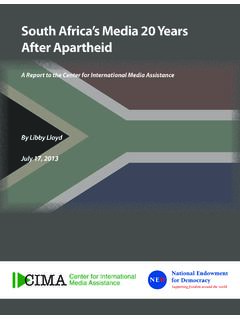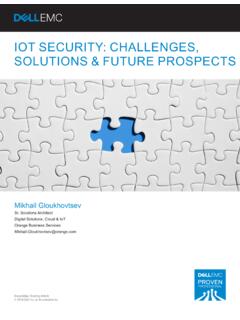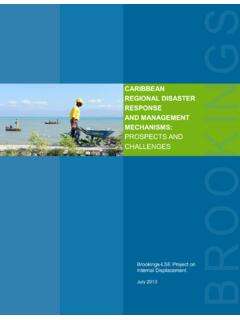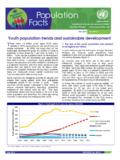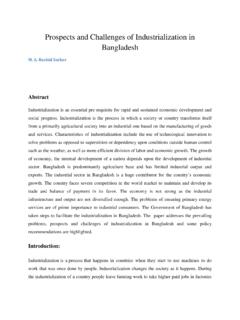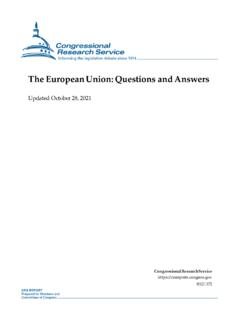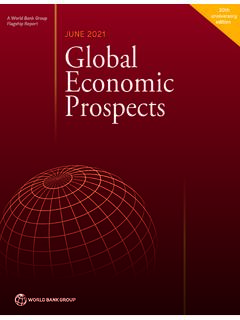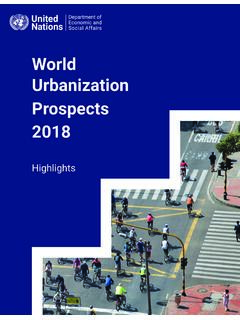Transcription of Community Radio: Its Impact and Challenges to its …
1 Community Radio: Its Impact and Challenges to its DevelopmentWorking Group ReportOctober 9, 2007 The Center for International Media Assistance (CIMA), a project of the National Endowment for Democracy, aims to strengthen the support, raise the visibility, and improve the effectiveness of media assistance programs by providing information, building networks, conducting research, and highlighting the indispensable role independent media play in the creation and development of sustainable democracies around the world. An im-portant aspect of CIMA s work is to research ways to attract additional private sector interest in and support for international media convenes working groups, discussions, and panels on a variety of topics in the field of media development and assistance. The center also issues reports and recommendations based on working group discussions and other investigations.
2 These reports aim to provide policymakers, as well as donors and practitioners, with ideas for bolstering the effectiveness of media assistance. Marguerite H. SullivanSenior DirectorCenter for International Media Assistance National Endowment for Democracy 1025 F Street, , 8th Floor Washington, 20004 Phone: (202) 378-9700 Fax: (202) 378-9407 Email: of ContentsPreface 3 Executive Summary 4 Background 6 The Social Impact of Community Radio 8 Challenges to Sustainability and Funding Perspectives of Community Radio 12 Ensuring an Enabling Environment for Community Radio Development 15 Recommendations 19 Endnotes 21 Appendix: Working Group Participants 22 Center for International Media Assistance 3 CIMA Working Group Report.
3 Community RadioOn October 9, 2007, the Center for International Media Assistance (CIMA) at the National Endowment for Democracy organized a working group to discuss the social Impact of Community radio and models for its sustainable development, as well as other key issues affecting Community radio development, including an enabling environment and funding strategies. CIMA is grateful for the valuable contributions of the working group participants. We extend our particular thanks to Joan Mower, public affairs officer at the Sudan Programs Group of the Department of State, for her skillful moderation of this important topic; to William Siemering, president of Developing Radio Partners, for his informative presentation and for providing a definition of Community radio ; and to Anahit Khachatryan for serving as the rapporteur and organizing the discussion into a consensus would also like to acknowledge Kim Mahling Clark, Kate Coyer, Kreszentia Duer, Carole Frampton, Daoud Kuttab, George Papagiannis, William Ryerson, and Paul-Andr Wilton for their insightful presentations that facilitated the group s discussion and structured much of the hope that this report will become an important reference for international media assistance H.
4 Sullivan Senior Director Center for International Media AssistancePreface4 Center for International Media AssistanceCIMA Working Group Report: Community RadioOn October 9, 2007, CIMA convened a working group of 27 experts to examine the Impact of Community radio, as well as the role and Challenges of Community radio development within the larger context of media development. The working group included Community radio developers and activists, representatives from donor and implementing organizations, as well as scholars and policymakers. The goal of the one-day meeting was to form recommenda-tions for policymakers on whether and how to address Community radio development within larger assistance contributions of the participants were as diverse as their backgrounds and affiliations. Representatives of implement-ing organizations brought firsthand accounts of where and why Community radio has been effective, what projects have been suc-cessful or unsuccessful and why, and what the main Challenges have been.
5 The group discussed creating an enabling environment for Community radio development, issues related to the sustainability of Community radio stations, and appropriate assistance strategies that donors and implementers should report highlights the working group s main points of discussion and recommenda-tions. The group s major findings can be summarized as follows: The Impact of independent media on society is cross-cutting and en-compassing, and thus should be regarded as a unique development sector. Within media development, it is essential to focus on Community radio as a powerful source for em-powerment, especially for disenfran-chised and marginalized groups in society. Research efforts to quantify, analyze, and draw conclusions regarding the Impact of Community radio are essential and can serve as a sound basis for assistance advocacy.
6 The most important aspects of Community radio, which serves a geographic group or a Community of interest, include the broad participa-tion by Community members often on a volunteer basis and the ownership and control of the station by the Community through a board of governors that is representative of the Community and responsive to the diversity of its needs. Where local need and potential is present, but the legal and political en-vironment conducive to Community radio development is absent, the in-ternational development Community should find ways to encourage gov-ernments to adopt and enforce legis-lation and regulations necessary for Community radio to operate. Long-term commitment and coor-dinated efforts are necessary for the institutional development of Community radio. Financial sustainability is a major challenge for Community radio stations.
7 Possible solutions to boost struggling Community radio efforts include a well-coordinated pooled Executive Summary Center for International Media Assistance 5 CIMA Working Group Report: Community Radiofunding source, or a microcredit loan system for Community radio develop-ment that is not subject to donor priori-ties. Donor support is not limitless. Although sustainability of funding recipients should not be the primary objective of donors, funding strate-gies and development models should encourage sustainability in the long run. Donors should provide equipment and technological support adequate for the local setting, and comprehensive training preparing funding recipients for sustainability even in changing en-vironments. Networks of Community radio stations can serve as effective and efficient fora for exchange of programming, creation of national news, and information programs.
8 Professional associations can play a vital role in establishing professional codes of ethics, identify-ing training needs, and establishing training programs. They can also serve as advocates for the sector, soliciting more funds for development. Associ-ations and networks can thus become focal points for donor assistance. The media assistance Community should be alert to new prospects for Community radio development through digitization and the Center for International Media AssistanceCIMA Working Group Report: Community RadioIn the view of Community radio developers, Community radio stations often serve as the most trusted agent in town that brings change. 1 Community radio plays a vital role in building vibrant communities, in mobilizing groups to action by informing and empowering citizens, in giving voice to the marginalized groups of society, and in bringing Community needs to the attention of local and even national governments.
9 The scope of the actual and potential Impact of Community radio is wide-ranging, many agree, as are the Challenges associated with Community radio development. Community radio activists who have seen both the benefits and the difficulties of Community radio claim that the donor Community does not fully recognize the wide-ranging benefits of Community radio in development and thus fail to respond to the Challenges of this media sector. To address this gap, 27 participants including Community radio developers and activists, representatives from donor and implement-ing organizations supporting and involved in Community radio projects, as well as scholars and policymakers came together under the auspices of the Center for Inter-national Media Assistance at the National Endowment for Democracy to explore the role funders, particularly the govern-ment, can play in fostering Community radio to the discussion, Developing Radio Partners President William Siemering offered a working (although non-exhaustive) definition of Community radio: Community radio that serves a geographic group or Community of interest is licensed to a nonprofit organization2 to serve the public interest by.
10 Electing a governing board that reflects the diversity of the Community , defines the mission, sets policy, is financially re-sponsible, and appoints the manager; creating structures and processes to identify Community needs and interests that inform programming decisions and evaluate the effectiveness of the pro-gramming; ensuring broad participation in program-ming, giving value to communication among the people to facilitate positive change, not simply relaying information to the citizen; ensuring that the service is trustworthy, accurate, and independent of outside in-fluences, be they government, [commer-cial,3] special interests, or religions. 4 The slogan of a Community radio station in Mongolia Your radio is listening speaks volumes about the nature of this medium. Community radio is about the hori-zontal exchange of information a partici-patory interaction between the Community and the radio station rather than a vertical, one-way communication method, delivering information from a medium to the public.
